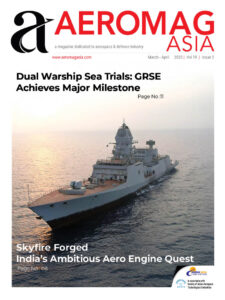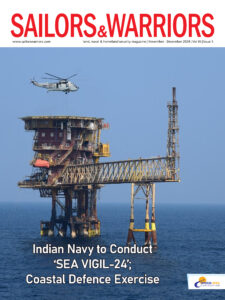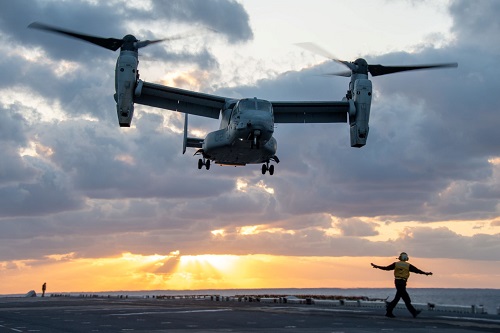 The Bell Boeing V-22 Osprey has logged more than 600,000 flight-hours, providing continuous customer support to maintain mission readiness and transport critical cargo and personnel.
The Bell Boeing V-22 Osprey has logged more than 600,000 flight-hours, providing continuous customer support to maintain mission readiness and transport critical cargo and personnel.
Built by Bell Textron Inc., a Textron Inc. (NYSE: TXT) company, and Boeing [NYSE: BA], the V-22 fleet has grown to more than 400 aircraft and is operated by the United States Marine Corps, U.S. Air Force, U.S. Navy, and the Japan Ground Self-Defense Force.
The V-22 is the only military production tiltrotor aircraft in the world. Its speed, range, maneuverability, and logistical capability make it one of the most versatile and cost-effective solutions for its customers.
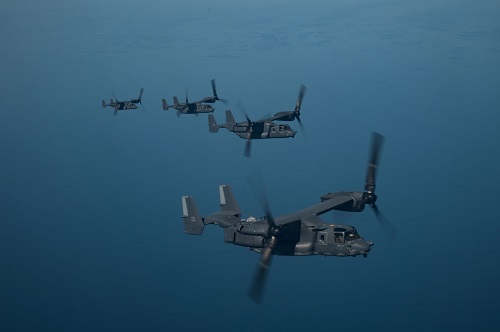 “There is no other aircraft in the world capable of matching the unique capabilities of the Osprey,” said Kurt Fuller, Bell V-22 vice president, and Bell Boeing program director. “The 600,000 flight-hours represent countless tactical, logistical and humanitarian assistance missions, and the dedication of the men and women who maintain and operate the aircraft every day to keep it an advanced aircraft.”
“There is no other aircraft in the world capable of matching the unique capabilities of the Osprey,” said Kurt Fuller, Bell V-22 vice president, and Bell Boeing program director. “The 600,000 flight-hours represent countless tactical, logistical and humanitarian assistance missions, and the dedication of the men and women who maintain and operate the aircraft every day to keep it an advanced aircraft.”
Bell Boeing directly supports V-22 readiness by providing comprehensive global services to V-22 squadrons, including maintenance support, training, on-site field representatives, data analytics, and new and repaired parts. For example, the Naval Air Systems Command recently awarded Bell Boeing a contract to deliver and install kits for nacelle improvements and the conversion area harness onto the CV-22 aircraft for the Air Force. The program refines the design of the nacelles and wiring harnesses for better reliability and maintainability, ultimately reducing repair time and improving readiness.
“Each V-22 flight hour is the product of a team effort,” said Col. Matthew Kelly, V-22 Joint Program Office program manager. “Enabled by pilots, maintainers, testers, engineers, the program workforce, and our industry partners who, together, ensure safe and effective V-22 operation.”
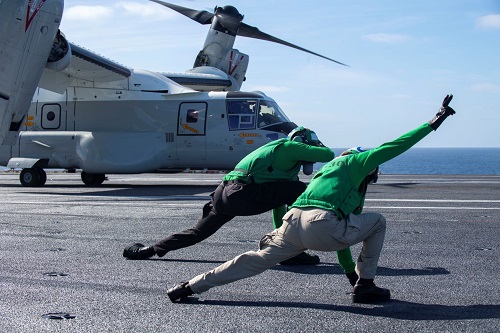 Recent program accomplishments include the V-22’s latest variant, the CMV-22B, assigned to the “Titans” of Fleet Logistics Multi-Mission Squadron 30, completing the first delivery of an F-35 engine to the USS Carl Vinson, along with successful paradrops with the U.S. Navy’s parachuting team, “The Leap Frogs,” earlier in the year.
Recent program accomplishments include the V-22’s latest variant, the CMV-22B, assigned to the “Titans” of Fleet Logistics Multi-Mission Squadron 30, completing the first delivery of an F-35 engine to the USS Carl Vinson, along with successful paradrops with the U.S. Navy’s parachuting team, “The Leap Frogs,” earlier in the year.
“From its first flight over 30 years ago to achieving this significant flight-hour milestone, the V-22 has a demonstrated legacy of mission success,” said Shane Openshaw, Boeing V-22 vice president, and Bell Boeing V-22 deputy program director. “As we look at optimizing future sustainment and support, our customer partnerships and commitment to innovation, flexibility, and agility will ensure we build on the aircraft’s ability to support whatever the mission demands.”
Boeing is the world’s largest aerospace company and leading provider of commercial airplanes, defense, space and security systems, and global services. As a top U.S. exporter, the company supports commercial and government customers in more than 150 countries. Building on a legacy of aerospace leadership, Boeing continues to lead in technology and innovation, deliver for its customers and invest in its people and future growth.

